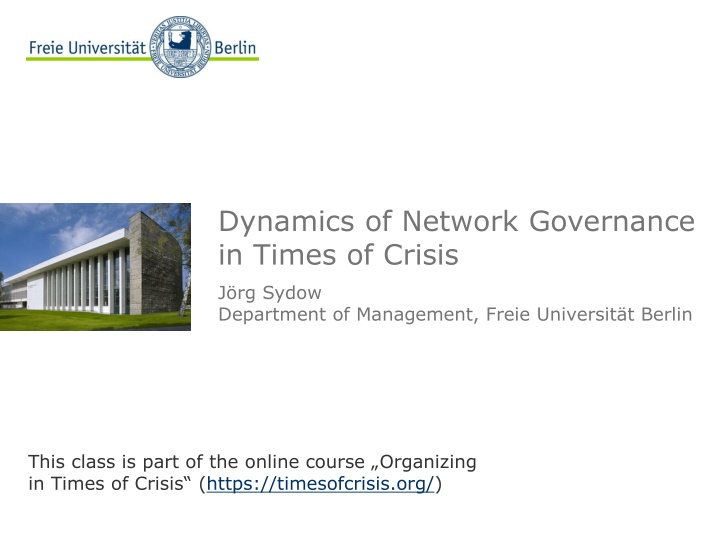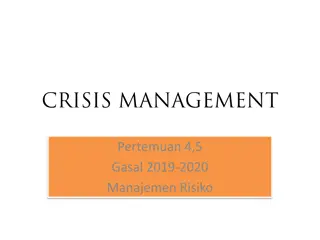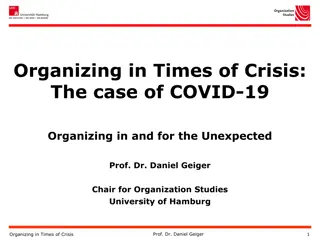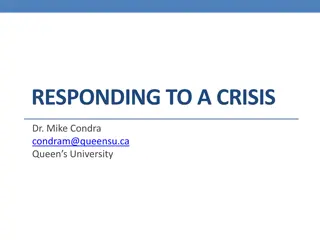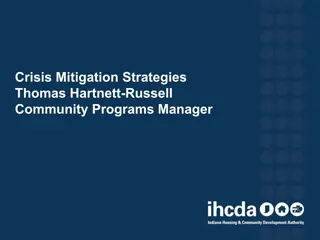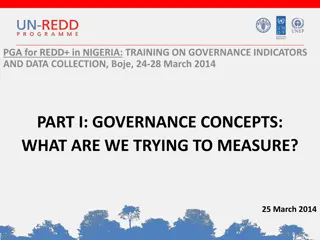Dynamics of Network Governance in Times of Crisis
This class delves into the role of networks as alternatives to bureaucratic organizations during crises, examining interorganizational networks, their management, and governance dynamics in various sectors like healthcare and global supply chains. The course explores network perspectives on governance voids and interactive governing behaviors in times of crisis.
Download Presentation

Please find below an Image/Link to download the presentation.
The content on the website is provided AS IS for your information and personal use only. It may not be sold, licensed, or shared on other websites without obtaining consent from the author.If you encounter any issues during the download, it is possible that the publisher has removed the file from their server.
You are allowed to download the files provided on this website for personal or commercial use, subject to the condition that they are used lawfully. All files are the property of their respective owners.
The content on the website is provided AS IS for your information and personal use only. It may not be sold, licensed, or shared on other websites without obtaining consent from the author.
E N D
Presentation Transcript
Dynamics of Network Governance in Times of Crisis J rg Sydow Department of Management, Freie Universit t Berlin This class is part of the online course Organizing in Times of Crisis (https://timesofcrisis.org/)
Overview Learning Aims (1)Networks as an Alternative to Bureaucratic Organizations in Times of Crisis (2)Interorganizational Networks as a Form of Governance (3)How are Inter-organizational Networks Managed? Functions, Practices, Institutions (4)Understanding Network Dynamics: A Governance View on the FED in D sseldorf (by reading and reflecting on the FED case) J rg Sydow - Dynamics of Network Governance in Times of Crisis 2
Networks as an Alternative to Bureaucracies in Times of Crisis? What kind of networks are particulary relevant? Healthcare networks: In- and outpatient care, rehabilitation, home for the elderly, integrated care Global supply chains/networks: Food, pharma, PPE, medical instruments, R&D consortia for testing, tracking, treatment and vaccination Organizing for interest representation: formal associations vs. ad-hoc networks (incl. for organizing for conversion) Policy networks J rg Sydow - Dynamics of Network Governance in Times of Crisis 3
Interorganizational Networks as a Form of Governance Overview Networks as a form of governance network perspective Inter- and intraorganizational networks Networks between or beyond market and hierarchy (Williamson 1991; Powell 1990) Modes of network governance (Provan & Kenis 2008; Kenis et al. 2019) Governance modes and network management (Sydow et al. 2016), filling governance voids through interactive governing behavior (Jarvenpaa & V linkangas 2016) J rg Sydow - Dynamics of Network Governance in Times of Crisis 4
Interorganizational Networks as a Form of Governance An Intermediary Form? a) Network as a hybrid form of governance (Willamson 1991) Market coordination NETWORK Hierarchical coordination Network formation between market and hierarchy (Sydow et al. 2016: 13) J rg Sydow - Dynamics of Network Governance in Times of Crisis 5
Interorganizational Networks as a Form of Governance An Intermediary Form? a) Network as a hybrid form of governance (Willamson 1991) Market coordination NETWORK Hierarchical coordination b) Network beyond market and hierarchy (Powell 1990) NETWORK Market coordination Hierarchical coordination J rg Sydow - Dynamics of Network Governance in Times of Crisis 6
Forms of Network Governance I Following Provan & Kenis (2008): 1. Shared governance 2. Lead-organization governance 3. Network administrative organization (NAO) Networks give preference to one of these modes, depending on: (1) the level of trust, (2) the number of participants, (3) the extent of goal consensus, and (4) the need for network-level competencies. Beyond a contingency theory of network governance: dynamics and practices (Berthod et al. 2017) J rg Sydow - Dynamics of Network Governance in Times of Crisis 7
Forms of Network Governance II Kenis et al. (2019) adding to Provan & Kenis (2008): 4. Shared governance with NAO 5. Lead-organization governance with NAO 6. Core-periphery model or: more than one lead organization (Kenis et al. 2019) Organizational network governance approach (Raab et al. 2020) J rg Sydow - Dynamics of Network Governance in Times of Crisis 8
Network Management: Functions, Practices, Institutions Trust Control Cooperation Selection Competition Management Practices Regulation Allocation Evaluation Stability Change Source: Sydow et al. (2016), p. 20 J rg Sydow - Dynamics of Network Governance in Times of Crisis 9
Network Management: Functions, Practices, Institutions Interorganizational: NAO Interorganizational committees (IOCs) Interorganizational projects (IOPs) Networking tools (physical as well as virtual) Intraorganizational: Boundary spanning individuals, teams (incl. TMT), dept, J rg Sydow - Dynamics of Network Governance in Times of Crisis 10
Learnings Next Steps (1)Interorganizational networks are an important alternative to bureaucratic organizations, also in times of crisis. (2)Such networks can be viewed as a form of governance either between OR beyond market and hierarchy. (3)Beyond looking at (static) governance structures network management practices are important, including managing tensions and contradictions. (4)Look at the network dynamics in the case of the FED (Berthod et al. 2017) a lead-organization of an High-Reliability Network or HRN. Do not forget to answer the post-lecture questions! J rg Sydow - Dynamics of Network Governance in Times of Crisis 11
References Berthod, O., Grothe-Hammer, M., M ller-Seitz, G., Raab, J., & Sydow, J. (2017). From high-reliability organizations to high-reliability networks: The dynamics of network governance in Times of Crisis. Journal of Public Administration Theory, 27 (2): 352-371. Jaarvenpaa, S.L., & V linkangas, L. (2016). From governance void to interactive governing behavior in new research networks. Academy of Management Discovery, 2(3): 226-246. Powell, W.W. (1990). Neither market nor hierarchy: Network forms of organization. Research in Organizational Behavior, 12: 295-336. Provan, K.G., & Kenis, P.N. (2008). Modes of network governance: Structure, management, and effectiveness. Journal of Public Administration Research and Theory, 18: 229-252. Raab, J., Kenis, P., Kraaj-Dirkzwager, M., & Timen, A. (2020). Ex ante knowledge for infectious disease outbreaks. Introducing the organizational network governance approach. In: Gl ckler, J., Herrigel, G., & Handke, M. (Eds.). Knowledge for Governance. Berlin: Springer (in print). Sydow, J., Sch ler, E., & M ller-Seitz, G. (2016). Managing Inter-organizational Relations: Debates and Cases. London: Palgrave Macmillan. Williamson, O.E. (1991). Comparative economic organization: The analysis of discrete structural alternatives. Administrative Science Quarterly, 36 (2): 269-296. J rg Sydow - Dynamics of Network Governance in Times of Crisis 12
